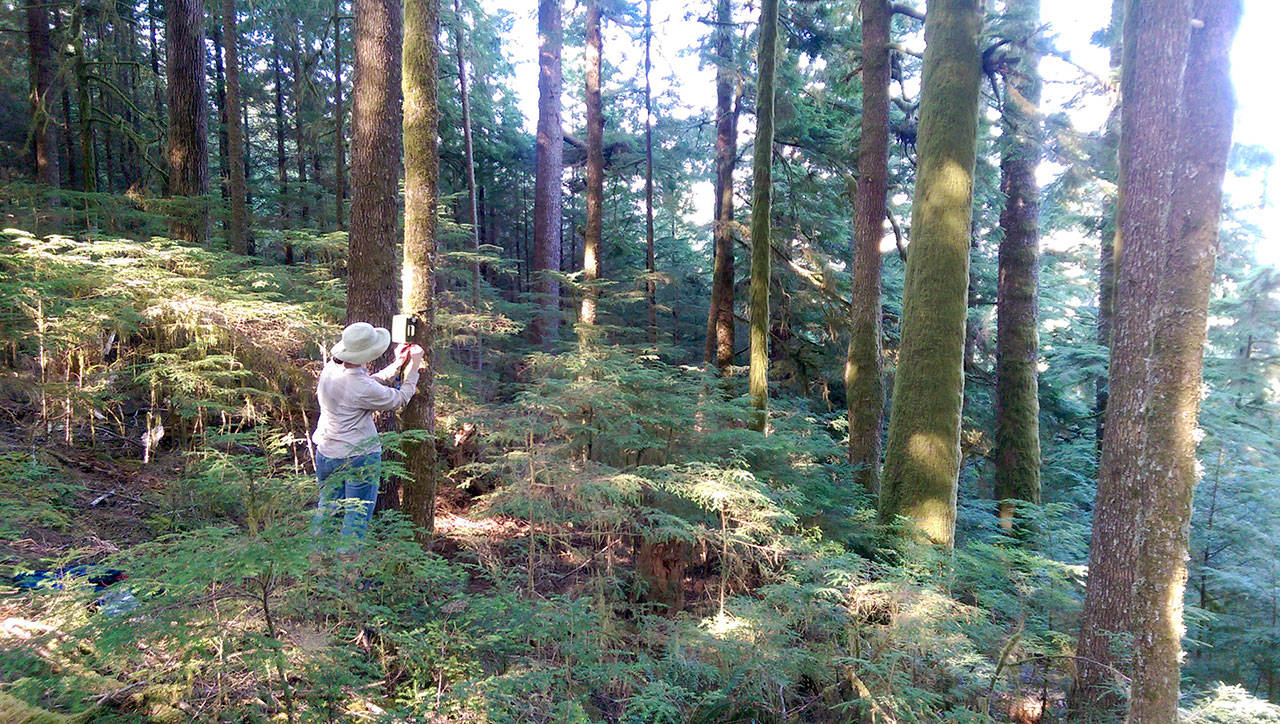They’ve been close neighbors sharing the same sky. But Naval Air Station Whidbey Island and a team of research scientists on the North Olympic Peninsula report starkly different findings on aircraft noise and its effects on life.
A new University of Washington study, published in the journal Northwest Science, looks at — and listens to — NASWI’s Growlers, the Boeing electronic warfare jets taking off from Whidbey and flying over western Olympic National Park, long recognized as one of the world’s quietest places.
Researcher Lauren Kuehne of Bremerton, the lead author, embarked on the study after learning of the Navy’s plans to increase training flight activities over the Peninsula.
“2016 was when the Growlers started flying,” Kuehne said, adding that when she first heard about the noise, she’d scoffed.
Then “I experienced it,” she said, working on an earlier research project on the Peninsula.
Yet when Kuehne looked for scientific data on noise levels and impact, she found none.
Kuehne, then a researcher with the UW’s School of Aquatic & Fishery Sciences and now an independent consultant, gathered funding from the university, the Suquamish Foundation and the One Square Inch of Silence Foundation, headed by acoustic ecologist Gordon Hempton of Joyce.
From mid-2017 till summer 2018, Kuehne and UW fishery sciences professor Julian Olden used recorders to capture sound at Third Beach, in the Hoh watershed and along the Hoh River Trail.
With volunteers recruited and trained for the study, they processed some 3,000 hours of audio. Of the nearly 5,800 flight events reported, 88 percent were military aircraft.
This noise, the researchers reported, registered mostly between 45 and 60 decibels, comparable to air traffic sounds in Seattle. Occasionally the sound level would hit 80 decibels or more, which Kuehne likened to the steady roar heard when walking under Seattle’s former waterfront viaduct.
Most of these were Growler flights, Kuehne noted. She also found the people who live near the monitoring sites, beside the western swath of Olympic National Park, have a variety of feelings about the jets’ rumble.
“Everybody notices it. The extent to which people are bothered by it is quite variable,” she said.
When she was working on the West End, some told her this study was a waste of time. Some said the Navy is fulfilling an important mission. Still others said the jets’ noise and unpredictability causes them considerable stress, making it difficult to learn in school or sleep at night.
On the other side of the Peninsula, Port Townsend Mayor Michelle Sandoval said the Growler presence has rattled many residents, especially during the 2020 pandemic.
“People have definite mental stress reactions to it. So many people are home, feeling locked down — and they also have to experience noise,” she said.
Sandoval remarked too on the disconnect between the Navy and organizations such as the Puget Sound Partnership and Wild Olympics advocates. The military, she said, should be held to the same standard of care for human and environmental health.
In response, NASWI spokesman Mike Welding wrote in an email that the Navy has been flying over the Olympic Peninsula for decades. Previous to the Growlers, NASWI flew Prowlers, whose sound was a high-pitched whine. The Growlers are no louder, he said, but their lower frequency rumble may cause “noise-induced vibrations.”
“The Navy feels its analysis of potential effects on humans and wildlife on and around the Olympic Peninsula is accurate and not causing harm,” Welding wrote.
The Growlers “are one of many sources of man-made noise in this area, but the Navy’s aircraft activity occurs in a relatively small portion of the overall Olympic Peninsula, and occurs very intermittently,” he added.
A “potential increase” in Navy training flights over the Peninsula is on the horizon: from today’s average of about 2,300 flights yearly to 2,600. The increase will be incremental through 2024, Welding wrote.
“The normal daily average during weekdays would be about eight to 10 flights a day,” he noted, adding that could rise to 16 takeoffs on a very busy day.
Hempton, whose One Square Inch of Silence Foundation was inspired largely by the quietude of the Hoh Rainforest, sees Olympic National Park as a catalyst for change — albeit a tragically noisy one.
There was a time not long ago, he said, when the park perched atop worldwide must-visit lists, alongside places like the Taj Mahal. He believes the advent of the Growlers has changed that.
“Visitors are beginning to complain. They’ve come here to experience world-class quiet, the antidote to toxic noise,” he said.
If the noise keeps up, Hempton believes, the park’s appeal, reputation and the accompanying tourism revenue for the North Olympic Peninsula will be damaged. People the world over crave peaceful places, he said, and they will pay dearly for the retreat.
The Navy must find other training airspace, he said, away from the UNESCO World Heritage site and biosphere reserve that is Olympic National Park.
But don’t wait for the military to make such changes, Hempton added, acknowledging that studies such as the UW’s aren’t likely to alter the Growlers’ course.
“We should look to [U.S. Rep.] Derek Kilmer and [U.S. Sen.] Maria Cantwell to take a firm stand,” to start. He believes the need to restore tourism on the Peninsula post-pandemic — with its accompanying economic development — will motivate state and national leadership.
Only then, Hempton said, “quiet will prevail.”
________
Jefferson County senior reporter Diane Urbani de la Paz can be reached at 360-417-3509 or durbanidelapaz@peninsuladailynews.com.

